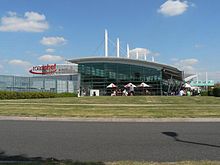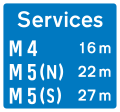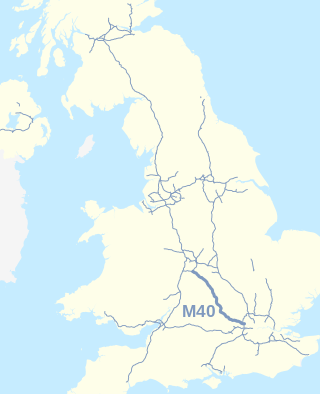
The M40 motorway links London, Oxford, and Birmingham in England, a distance of approximately 89 miles (143 km).
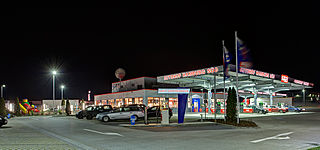
A rest area is a public facility located next to a large thoroughfare such as a motorway, expressway, or highway, at which drivers and passengers can rest, eat, or refuel without exiting onto secondary roads. Other names include motorway service area (UK), services (UK), travel plaza, rest stop, oasis (US), service area, rest and service area (RSA), resto, service plaza, lay-by, and service centre (Canada). Facilities may include park-like areas, fuel stations, public toilets, water fountains, restaurants, and dump and fill stations for caravans / motorhomes.

National Development Plan is the title given by the Irish Government to a scheme of organised large-scale expenditure on (mainly) national infrastructure. The first five-year plan ran from 1988 to 1993, the second was a six-year plan from 1994 to 1999 and the third ran as a seven-year plan from 2000 to 2006. A fourth National Development Plan ran from 2007 to 2011. The main elements of the third plan were the development of a national motorway network between the major cities in Ireland. The upgrading of the rail network was a secondary scheme.

The M1 is a motorway in Northern Ireland. It is the longest motorway in Northern Ireland and runs for 38 miles (61 km) from Belfast to Dungannon through County Antrim, County Down, County Armagh and County Tyrone. It forms part of the route via the A1 in Northern Ireland between Belfast and Dublin as well as being a part of the unsigned European E01 and E18 routes.
Welcome Break Limited is a British motorway service station operator that operates 35 motorway service stations in England, Scotland and Wales. It is the second-largest motorway service area operator behind Moto. It also operates hotels and motels. It is a subsidiary of Applegreen.

Moto Hospitality Limited, trading as Moto, is a British service station operator which operates 59 motorway service stations across the United Kingdom. It is currently the UK's largest service area operator.

Donington Park is a motorway service station owned by Moto, near Kegworth village in the English East Midlands. It is accessed from the M1 motorway by junctions 23a and 24, and is part of the complex of junctions involving the A42, A453, A50 and A6 roads. The service station is adjacent to East Midlands Airport and the East Midlands Gateway freight terminal, and is some 3 miles (4.8 km) from the Donington Park motorsport circuit, from which it takes its name.

Woolley Edge services is a motorway service station on the M1 motorway within the borough of the City of Wakefield, West Yorkshire, England. It lies between junctions 38 and 39 close to West Bretton and west of the village of Woolley.

Trowell services is a motorway service station off the M1 motorway in Trowell, Nottinghamshire, England, situated north of Junction 25. Opened in 1967 by Mecca Leisure, it is currently owned by Moto. The services are situated near Nottingham.
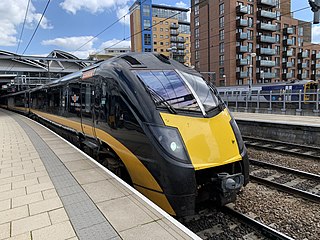
Transport in Leeds consists of extensive road, bus and rail networks in Leeds, West Yorkshire, England. Public transport in the Leeds area is coordinated and developed by West Yorkshire Metro. The city has good rail and road links to the rest of the country. Leeds railway station is one of the busiest in Britain, and Leeds is connected to the national road network via the A1(M) motorway, M1 motorway and M62 motorway. The city is served by Leeds Bradford Airport.

The M9 motorway is a motorway in Ireland linking the M7 between Naas and Newbridge near Kilcullen to Waterford. Opened in sections between 1994 and 2010, the final section opened on 9 September 2010.

Extra MSA Services Ltd is a company that operates nine motorway service stations in England, mainly on primary routes. It is based at Beaconsfield services, previously being in the centre of Lincoln. It is also known as Extra MSA Forecourts Ltd.

In Ireland, the highest category of road is a motorway, indicated by the prefix M followed by a one- or two-digit number. The motorway network consists entirely of motorway-grade dual carriageways and is largely focused upon Dublin. There are also several three-lane motorways, while Ireland's busiest road, the M50, incorporates four-lane, five-lane, and six-lane stretches.
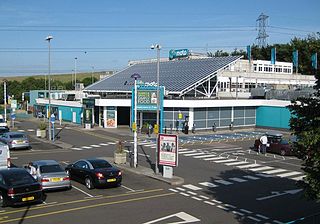
Toddington Services is a motorway service station on the M1 motorway between junctions 11A and 12, just north of Luton and Dunstable in Bedfordshire, England. It takes its name from the nearby village of Toddington. It is owned by Moto Hospitality.

Beaconsfield services is a motorway service station on the M40 motorway in Beaconsfield in Buckinghamshire, England. It is operated by Extra, and opened on 17 March 2009. It is the fourth and most recent of the service areas to be built on the 89-mile motorway which links London, Oxford and Birmingham. At its opening, it was the largest motorway service area in the United Kingdom. The petrol station with 36 pumps is also the largest filling station in the country. Petrol stations are provided by Shell and a hotel is operated by Ibis Budget.

Cobham services is a motorway service area on the M25 motorway in Surrey between junctions 9 and 10. It is operated by Extra MSA and was opened for business on 13 September 2012. Its planned opening date was scheduled to be early 2010, but was changed to early 2012 following various planning issues. The services were constructed as there was concern with the large 65 mile (104 km) gap without any service areas. At either end of that stretch of motorway was South Mimms services and Clacket Lane services, and the Secretary of State explained there was a clear and compelling need for a further service area. The other service area serving the motorway is Thurrock.
Rugby services is a motorway service station operated by Moto Hospitality and situated at junction 1 of the M6 motorway in Warwickshire, England.
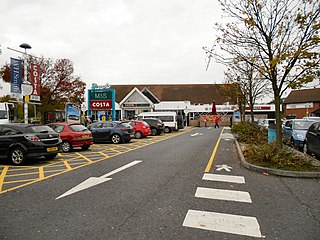
Ferrybridge services is a motorway services area (MSA) operated by Moto named after Ferrybridge in West Yorkshire, England. The site has easy access from the M62 motorway and the A1(M) motorway. Originally opened in 1985 under the Granada brand, the MSA at Ferrybridge has been under the Moto brand since 2001.

The Vale of York services is a future motorway service area (MSA) on the A1(M) in North Yorkshire, England. The MSA will be located on the western side of the motorway between Junctions 48 and 49, with access to both the northbound and southbound carriageways. The planning application has been submitted multiple times between 2001 and 2021.
